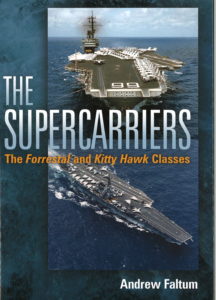 By Andrew Faltum, Naval Institute Press, Annapolis, MD (2014)
By Andrew Faltum, Naval Institute Press, Annapolis, MD (2014)
Reviewed by Mark Lardas
They were the first aircraft carriers designed from the keel up to operate jet aircraft. When they appeared, they were so big a jump over their World War II predecessors; they were considered not just aircraft carriers, but rather supercarriers. And now they all are gone.
The Supercarriers: The Forrestal and Kitty Hawk Classes, by Andrew Faltum, tells their story. The book examines eight ships: four Forrestals, three Kitty Hawks, and John F. Kennedy (a fossil-fuel design that followed the nuclear-powered Enterprise).
The book offers a workmanlike introduction to these vessels, offering an overview of their development, and the operational histories of the classes discussed and the individual ships.
Faltum does a first-rate job describing the environment in which these vessels were created in. In many ways, the first four chapters, presenting design and development of these carriers, are the most interesting in the book. Faltum shows how the resulting design was a compromise between the goals they were to achieve and the limitations under which they operated.
The discussion is nicely bookended with an examination of the unbuilt United States in the late 1940s and the rise of the nuclear-powered carriers in the 1960s. The United States discussion bridges carrier design from World War II up to the Forrestal. The rise of the nuclear carrier reveals how the nuclear carrier superseded the oil-fired vessels.
Those expecting a detailed, nuts-and-bolts breakdown of the individual classes will be disappointed. Faltum keeps things at a high level. There are overhead and side views of Saratoga and Constellation on the endpapers, and three smaller drawings showing internal arrangements of the ships in one of the appendices. The book contains 85 pages of appendices. These too, are high level collections of data. The bulk of the appendices are a list of the composition of the air group of each carrier while in commission.
The Supercarriers also spend significant space describing the various aircraft, missiles, and weapons systems deployed on these ships. These comprise carriers’ weapons, much like battleship guns; make up its striking power. As such they form an important context for the operation history of a carrier. These tend to independent of the carrier, however. Someone interested in the ships rather than the carrier system may be disappointed. Of greater interest to naval architecture buffs are Faltum’s discussions of systems such as catapults and radar.
The result is a book that feels like a supersized Osprey New Vanguard, one with twice the pictures, six times as many pages, and no color plates. The greater size offers more scope for an expansive discussion on operational history, which those interested in history will appreciate.
The Supercarriers is great for those looking for a comprehensive introduction to this subject. Wargamers may find the technical specifications and air group listing useful. Model-makers or those interested in technical detail may not find much, but The Supercarriers should interest those whose primary focus is history.
Mark Lardas is a frequent contributor to Naval History Book Reviews


John J. McDonough, MD